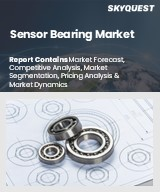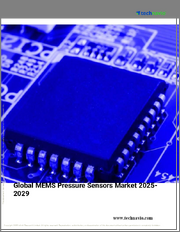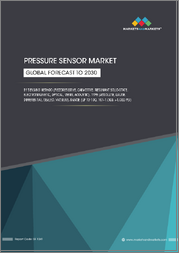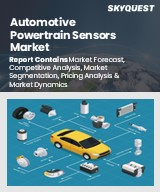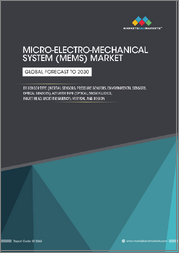
|
시장보고서
상품코드
1685836
압력 센서 산업 : 시장 점유율 분석, 산업 동향, 통계, 성장 예측(2025-2030년)Pressure Sensors Industry - Market Share Analysis, Industry Trends & Statistics, Growth Forecasts (2025 - 2030) |
||||||
압력 센서 산업은 2025년 199억 3,000만 달러, 2030년에는 311억 8,000만 달러로 성장할 것으로 예측되며, 예측 기간(2025-2030년)의 CAGR은 9.37%로 성장할 것으로 예상됩니다.

주요 하이라이트
- 압력 센서는 스테인리스 스틸이나 실리콘 등으로 만들어진 다이어프램에 대해 기체나 액체의 압력을 측정하고, 측정값을 전기 신호로 변환하여 출력하는 감압 소자를 갖춘 장치입니다.
- 정적 및 동적 압력 변화에 대한 지속적인 데이터 수집 및 수집은 대부분의 제조 장비 및 산업 기관 및 많은 소비자 제품이 제대로 작동하는 데 필수적입니다. 과도한 압력은 출력의 열화 및 부정적인 변화와 같은 문제를 야기하며, 일반적으로 용도의 정상적인 성능을 손상시킬 수 있습니다. 최근 압력 센서는 디지털화, 소형화, 저비용화, 저소비 전력화가 진행되어 수익 급증에 긍정적인 영향을 미치고 있습니다. 이러한 변화는 센서의 효율과 성능을 향상시키고 혁신의 새로운 파도를 창출합니다.
- 압력 센서에는 다양한 용도가 있으며, 다양한 센서 유형과 특성이 요구되고 있습니다. 가혹한 환경이나 부식성이 높은 환경에 대응하는 것, 고신뢰성의 용도을 향한 것 등 다양한 유형가 있습니다. 예를 들어, 지난 수십년동안 자동차는 이러한 장치 수요를 견인하는 주요 부문 중 하나가되었습니다. 이 산업용 센서를 제조하는 기업은 종종 IATF 16949, ISO 21750:2006, ISO 1550-2:2012, ISO 26262 등의 인증을 유지해야 합니다. 자동차 산업용 압력 센서는 ISO 1142-4의 전기 간섭에 대한 내성 요건을 충족해야 합니다.
- 시장의 성장은 자동차의 안전기능에 대한 수요 증가, 정부규제 증가, 자동차산업의 성장에 기인하고 있습니다. 엄격한 안전 규제가 존재하고 설계자가 자동차 압력 센서를 주로 엔진 최적화, 배기 가스 제어 및 안전 강화의 세 가지 응용 분야에서 사용하기 때문에 압력 센서의 역할이 강화될 것으로 예상됩니다.
- 센서 시장은 다양해지고 성장하고 있으며, 설계 엔지니어는 자동차에서 스마트폰에 이르기까지 모든 센서에 많은 센서를 담아 스마트 칫솔과 고양이 화장실과 같은 새로운 용도에 적용하고 있습니다. 센서가 보급됨에 따라 비용에 대한 우려가 엔지니어를 괴롭히고 있습니다. 센싱 제품과 관련된 높은 비용은 시장 성장을 방해할 것으로 예상됩니다.
- COVID-19 이후의 시나리오에서 2022년의 시작은 세계 소비자 전자 시장에 매우 중요했으며, 많은 요인들로 인해 매우 어려웠습니다. 예를 들어 우크라이나 전쟁의 영향과 인플레이션의 폭주로 인해 소비자 심리는 급격히 급락했습니다. 게다가 2022년 봄에는 가장 큰 판매 시장인 중국에서 록다운이 발생하여 판매에 더욱 부정적인 영향을 미쳤습니다. 주목할 만하게도, 4분기에 열리는 축구 월드컵은 올 상반기의 부진을 만회할 기회를 제공할 것으로 예상되었지만, 경험상 이러한 주요 이벤트는 특히 TV 수요 증가와 같은 일시적인 수요 증가에 그치는 경우가 많았습니다. 그러나 소비자 심리의 악화를 감안할 때, 이 효과는 2022년 동안 가전 시장의 매출 감소를 억제할 정도로 크지 않습니다.
압력 센서 산업 동향
자동차가 큰 점유율을 차지할 전망
- 자동차 분야의 압력 센서는 타이어 공기압, 브레이크 유압, 연료 탱크 내의 증기압, 연료 분사와 CDRi, 매니폴드 절대압 등의 주요 요인에 의해 구동되어 응용 기회를 창출하고 있습니다.
- 오랫동안 압력 센서는 엔진 오일, 기어 박스 및 변속기 오일, 브레이크, 냉각, 연료 시스템의 유압 오일과 같은 중요한 유체 압력을 측정하기 위해 자동차 부문을 포함한 다양한 산업에서 널리 사용되어 왔습니다. 자동차 산업은 안전, 편안함 및 엔터테인먼트를 향상시키기 위해 기술적 진보를 이루고 있으며 다양한 압력 센서 옵션을 제공합니다. 이러한 센서의 컴팩트한 크기는 자동차 설계에 널리 채택되는 데 크게 영향을 미칩니다.
- 게다가, 압력 센서는 실내에서 손가락의 권선을 방지하기 위해 전기자동차에서 이용됩니다. 또한 대부분의 전기자동차 냉각 시스템은 배터리 팩을 최적의 작동 온도로 장시간 유지하기 위해 노력하고 있습니다. 자동차 제조업체가 전기자동차에 대용량 배터리 팩을 탑재하려고 함에 따라 이러한 요구를 관리하는 냉각 시스템에 대한 요구도 커지고 있습니다.
- 따라서 압력 측정은 전기자동차의 액체 냉각 시스템에서 매우 중요한 요소입니다. 압력 센서는 냉각 시스템의 조정과 최적화를 위한 피드백을 제공하고 누설을 나타낼 수 있는 압력 손실을 감지하는 데 매우 중요한 역할을 합니다. 액체 냉각 시스템이 복잡해짐에 따라 전기자동차 냉각 시스템을 위한 정밀하고 탄력적인 압력 센서의 필요성이 그 어느 때보다 높아질 것으로 예상됩니다.
- 마이크로 일렉트로메카니컬 시스템(MEMS) 센서는 압력 감지 및 에어 매스 플로우 센서로 사용됩니다. 기술의 발전으로 보다 작고 배터리가 없는 타이어 공압 센서 모듈이 개발되었습니다. MEMS 기반 에너지 수확 시스템은 현재 모듈 크기를 줄이기 위해 타이어에 내장되어 있습니다.
- 전기자동차의 판매와 생산이 증가함에 따라 배터리 냉각액 및 증기 감지 등 다양한 용도의 압력 센서가 필요합니다. IEA에 따르면, 넷 제로 시나리오에서는 2030년까지 전기자동차 판매 대수가 자동차 판매 대수 전체의 약 65%를 차지하게 됩니다. 이러한 EV 판매 증가는 압력 센서에 대한 수요를 발생시킬 것으로 보입니다.
아시아태평양이 시장을 독점
- 중국은 세계의 의료산업에 있어 매우 유망한 시장으로 정부의 뒷받침과 인구동태의 진화가 결합되어 광대한 규모와 다양성, 성장의 가능성을 특징으로 하고 있습니다. 게다가 노인 증가와 뛰어난 의료기기에 대한 수요가 증가함에 따라 정부는 의료 분야 개발을 우선시하고 있으며 시장의 중요한 원동력이 되고 있습니다.
- 압력 센서는 챔버 내의 압력을 모니터링하고 치료 중에 투여되는 압력 수준을 조정하기 위해 의료기기에 사용됩니다. 중국은 의료기기 제조의 유명한 세계적인 기지입니다.
- 국가의료제품관리국에 따르면 중국의 의료기기 기업 수는 2022년 12월까지 32,632개에 달했고, 2008년 13,000개에서 꾸준히 증가하고 있습니다. 이들 기업의 90% 이상은 중소기업입니다. 이러한 중요한 능력은 이 지역에서 압력 센서의 응용 기회를 높일 것으로 보입니다.
- 일본의 자동차산업은 세계 3위의 자동차 생산량을 자랑하며 22개 현에 78개의 공장이 있습니다. 도요타, 경, 닛산 등 대기업이 일본 경제에 크게 공헌하고 있으며 자동차 제조업은 수송기계산업의 89%를 차지하고 있습니다.
- 또한 자동차 부품 공급업체의 성장은 일본 경제의 중요한 구성 요소가 되고 있습니다. 이러한 중요한 자동차 기능은 브레이크, 냉각, 연료 시스템의 엔진 오일, 기어 박스 및 변속기 오일, 작동유와 같은 중요한 유체의 압력을 측정하는 등 다양한 용도의 압력 센서에 대한 수요를 생성합니다. 또한 전기차(EV) 판매가 증가하고 있는 지역도 시장 수요를 자극할 것으로 예상됩니다.
- 압력 센서는 에어 필터의 상태를 모니터링하기 위해 HVAC 시스템에서 사용됩니다. 필터가 미립자로 막히면 전체 필터의 차압 상승을 감지할 수 있습니다. 인도의 압력 센서 수요는 HVAC 장비 수요 증가로 인한 것으로 추정됩니다. 이 지역의 도시 인구 증가로 인한 확대가 예상되는 주택 및 상업 인프라의 급속한 건설로 이 수요는 가속될 것으로 예상됩니다.
- 소비자용 전자기기 제조 증가, 자동차 산업 투자, 기타 분야의 개발은 아시아태평양에서 압력 센서센서에 대한 수요를 창출할 것으로 예상됩니다.
압력 센서 산업 개요
압력 센서 시장은 국내 외 업체들의 존재로 인해 세분화와 치열한 경쟁이 특징입니다. 업계의 기술 발전은 공급업체에게 지속 가능한 경쟁력을 제공합니다. 이 시장에서 주목할만한 기업으로는 ABB Ltd., TE Connectivity, Endress Hauser AG, Bosch Sensortec GmbH, All Sensors Corporation 등이 있습니다.
2023년 6월 Thermo Control은 Schneider Electric과 제휴하여 루마니아의 시비우에 IFM Prover사가 건설한 신 공장에 Ecostruxure Building Management System(BMS) 솔루션을 도입했습니다. 이 시스템은 공장의 모든 전기 및 기계 장비를 모니터링, 제어 및 관리하는 역할을 합니다. 또한 이 공장은 태양광 발전 패널과 히트 펌프를 BMS 솔루션에 통합하여 에너지 효율을 높이고 광열비를 절감했습니다. 또한 감시 및 제어 공정에 사용되는 온도, 습도 및 압력 센서는 IFM 공장 내에서 제조됩니다.
2023년 1월 보쉬 센서테크는 CES 2023에서 AI 대응 센서와 차세대 자력계를 포함한 일련의 신형 센서를 발표했습니다. 새롭게 발표된 BMP585 기압 센서는 수영용으로 설계된 웨어러블과 같은 까다로운 환경에서도 고급 추적 기능을 제공합니다. 이 센서는 초저전력을 자랑하며, 높은 정확도와 최소 노이즈 레벨을 제공하면서 배터리 수명 연장을 보장합니다.
기타 혜택 :
- 엑셀 형식 시장 예측(ME) 시트
- 3개월간의 애널리스트 서포트
목차
제1장 서론
- 조사의 전제조건과 시장 정의
- 조사 범위
제2장 조사 방법
제3장 주요 요약
제4장 시장 인사이트
- 시장 개요
- 업계의 매력도 - Porter's Five Forces 분석
- 공급기업의 협상력
- 구매자의 협상력
- 신규 참가업체의 위협
- 대체품의 위협
- 경쟁 기업간 경쟁 관계의 강도
- 업계 밸류체인 분석
- 매크로 동향이 시장에 미치는 영향
제5장 시장 역학
- 시장 성장 촉진요인
- 자동차나 헬스케어 등의 최종 사용자 업계의 성장
- 업계에서 MEMS 및 NEMS 시스템의 채용 증가
- 시장 성장 억제요인
- 센싱 제품의 고비용
제6장 시장 세분화
- 센서 유형별
- 유선
- 무선
- 제품 유형별
- 절대압
- 차동압
- 게이지압
- 기술별
- 압전 저항
- 전자식
- 용량성
- 공진 고체
- 광학식
- 기타 압력 센서
- 용도별
- 자동차
- 의료
- 가전
- 산업
- 항공우주 및 방위
- 음식
- HVAC
- 지역별
- 북미
- 미국
- 캐나다
- 유럽
- 영국
- 독일
- 프랑스
- 기타 유럽
- 아시아태평양
- 중국
- 일본
- 인도
- 기타 아시아태평양
- 라틴아메리카
- 중동 및 아프리카
- 북미
제7장 경쟁 구도
- 기업 프로파일
- ABB Ltd
- All Sensors Corporation
- Bosch Sensortec GmbH
- Endress Hauser AG
- TE Connectivity
- Honeywell International Inc.
- Schneider Electric
- Kistler Group
- Rockwell Automation Inc.
- Emerson Electric Co.
- Sensata Technologies Inc.
- SIEMENS AG
- Yokogawa Corporation
- Infineon Technologies Ag
- STMicroelectronics
- 압력 센서 벤더- 시장 점유율
제8장 투자 분석
제9장 시장 기회와 앞으로의 동향
SHW 25.04.01The Pressure Sensors Industry is expected to grow from USD 19.93 billion in 2025 to USD 31.18 billion by 2030, at a CAGR of 9.37% during the forecast period (2025-2030).
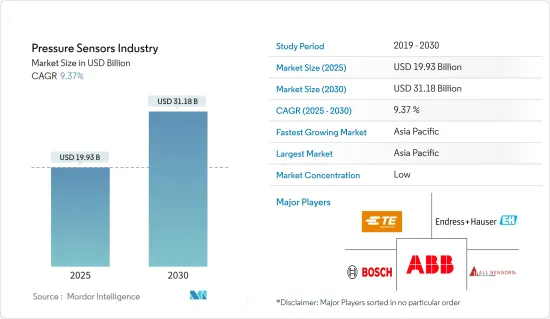
Key Highlights
- A pressure sensor is a device equipped with a pressure-sensitive element that measures the pressure of a gas or a liquid against a diaphragm made of stainless steel, silicon, etc., and converts the measured value into an electrical signal as an output.
- Gathering and collecting continuous data on static and dynamic pressure changes is vital for most manufacturing units and industrial institutions and for the proper operation of many consumer products. Overpressure could cause issues such as deterioration and negative shifts of outputs and generally harm the normal performance of applications. In recent years, pressure sensors have turned digital, miniaturized, lower-cost, and lower-powered, thus positively impacting its revenue surge. These changes have increased sensor efficiency and performance, generating a new wave of innovation.
- There are many different types of applications for pressure sensors, which create a need for a wide variety of sensor types and characteristics. Variants are available for harsh or corrosive environments and are aimed at high-integrity applications. For instance, in the last couple of decades, automotive has been one of the main sectors to drive demand for these devices. Companies that manufacture sensors for this industry must often maintain certification under IATF 16949, ISO 21750:2006, ISO 1550-2:2012, ISO 26262, and others. Pressure sensors in the automotive industry must also meet the requirements of ISO 1142-4 for resistance to electrical interference.
- The market's growth is attributed to the increasing demand for vehicle safety features, rising government regulations, and the growing automotive industry. With strict safety regulations coming into existence, the role of pressure sensors is expected to strengthen as designers use automotive pressure sensors primarily in three application areas: engine optimization, emission control, and safety enhancement.
- The market for sensors is getting diverse and growing, with design engineers packing more sensors into everything from automobiles to smartphones and applying them in new applications like smart toothbrushes and cat litter boxes. As sensors proliferate, concerns over cost continue to preoccupy engineers. The high costs associated with sensing products are expected to hinder the growth of the market.
- In the post-COVID-19 scenario, the start of 2022 was crucial as well as highly difficult for the global consumer electronics market due to numerous factors. For instance, the impact of the war in Ukraine and runaway inflation led consumer sentiment to plummet across the board. Additionally, in spring 2022, there were lockdowns in the largest sales market, China, which further negatively impacted sales. Notably, the football World Cup in the fourth quarter was expected to offer an opportunity to compensate for the weak first half of the year, but experience has shown that major events such as increased demand, particularly for TVs. However, given the poor consumer sentiment, this effect was not big enough to keep sales in the consumer electronics market from decreasing during 2022 overall.
Pressure Sensors Industry Trends
Automotive is Expected to Hold Significant Share
- The pressure sensors in the automotive sector are driven by major factors such as tire pressure, brake fluid pressure, vapor pressure in the fuel tank, fuel injection and CDRi, and manifold absolute pressure, among others, which create application opportunities.
- For a long time, pressure sensors have been extensively utilized in various industries, including the automobile sector, to gauge the pressure of crucial fluids such as engine oil, gearbox and transmission oil, and hydraulic oil in braking, cooling, and fuel systems. The automotive industry offers diverse pressure sensor alternatives as it undergoes technological advancements to enhance safety, comfort, and entertainment. The compact size of these sensors has significantly influenced their widespread adoption in automotive design.
- Moreover, pressure sensors are utilized in electric vehicles to prevent finger entrapment indoors. Additionally, most electric vehicle cooling systems strive to maintain battery packs at their optimal operating temperature for extended periods. As automakers endeavor to incorporate battery packs with greater capacity in electric vehicles, the requirements for these cooling systems to manage such demands are also escalating.
- Therefore, pressure measurement has emerged as a crucial factor in the liquid cooling system of an electric vehicle. Pressure sensors play a pivotal role in providing feedback for regulating and optimizing the cooling system and detecting pressure loss that may indicate leakage. With the increasing complexity of liquid cooling systems, the need for precise and resilient pressure sensors for electric vehicle cooling systems is anticipated to be higher than ever.
- Microelectromechanical systems (MEMS) sensors are utilized for pressure sensing and as an air mass flow sensor. Technological advancements have led to the development of more compact and battery-free tire pressure sensor modules. MEMS-based energy harvesting systems are currently integrated into tires to reduce module size.
- The increasing sales and production of electric vehicles necessitate pressure sensors for various applications, including battery cooling fluid and vapor detection. As per the IEA, electric vehicle sales will constitute approximately 65% of total car sales by 2030 in the Net Zero Scenario. Such rising EV sales will create demand for pressure sensors.
Asia Pacific to Dominate the Market
- China presents a highly promising market for the global medical industry, characterized by vast size, diversity, and growth potential, driven by a confluence of government backing and evolving demographics. Furthermore, with an increasingly elderly populace and heightened demand for superior medical equipment, the government has prioritized developing the healthcare sector, serving as a key impetus for the market.
- Pressure sensors are utilized in medical devices to oversee the pressure within the chamber and regulate the pressure level administered during treatment. China is a prominent global hub for medical device manufacturing.
- As per the National Medical Products Administration, the number of medical device companies in China reached 32,632 by December 2022, exhibiting a steady growth from 13,000 in 2008. Most of these companies, over 90%, are small and medium-sized enterprises. Such significant capabilities will enhance the application opportunities for the pressure sensors in the region.
- The automotive industry in Japan is the third-largest producer of automobiles globally, boasting 78 factories across 22 prefectures. Major companies such as Toyota, Kei, and Nissan contribute significantly to the country's economy, with automotive manufacturing accounting for 89% of the transportation machinery industry.
- Additionally, the growth of auto parts suppliers has become a substantial component of Japan's economy. Such significant automotive capabilities will create the demand for pressure sensors for various applications, such as to gauge the pressure of crucial fluids such as engine oil, gearbox and transmission oil, and hydraulic oil in the braking, cooling, and fuel systems. The region's progress in augmenting electric vehicle (EV) sales is also anticipated to stimulate market demand.
- Pressure sensors are utilized in HVAC systems to monitor the state of air filters. The rise in differential pressure across the filter can be detected as it becomes clogged with particulates. The demand for pressure sensors in India is estimated to rise due to the increasing demand for HVAC equipment. This demand is expected to accelerate due to the rapid construction of residential and commercial infrastructure, which is anticipated to expand as a result of the growing urban population in the region.
- The rising consumer electronics manufacturing, investments in the automotive industry, and developments in other sectors are expected to create the damned for pressure sensors in Asia-Pacific.
Pressure Sensors Industry Overview
The pressure sensor market is characterized by fragmentation and intense competition, with a presence of both domestic and international players. Technological advancements in the industry provide vendors with a sustainable competitive edge. Notable companies in this market include ABB Ltd., TE Connectivity, Endress+Hauser AG, Bosch Sensortec GmbH, and All Sensors Corporation.
In June 2023, Thermo Control, in partnership with Schneider Electric, implemented the Ecostruxure Building Management System (BMS) solution in a new factory constructed by IFM Prover in Sibiu, Romania. This system serves to monitor, control, and manage all electrical and mechanical installations within the factory. Additionally, the factory has integrated photovoltaic panels and heat pumps into the BMS solution, enhancing energy efficiency and reducing utility costs. Furthermore, the temperature, humidity, and pressure sensors utilized in the monitoring and control processes are manufactured within the IFM factory.
In January 2023, Bosch Sensortec unveiled a range of new sensors at CES 2023, including an AI-enabled sensor and a next-generation magnetometer. The newly introduced BMP585 barometric pressure sensors offer altitude tracking capabilities even in challenging environments, such as for wearables designed for swimming. These sensors boast ultra-low power consumption, ensuring extended battery life while delivering high accuracy and minimal noise levels.
Additional Benefits:
- The market estimate (ME) sheet in Excel format
- 3 months of analyst support
TABLE OF CONTENTS
1 INTRODUCTION
- 1.1 Study Assumptions and Market Definition
- 1.2 Scope of the Study
2 RESEARCH METHODOLOGY
3 EXECUTIVE SUMMARY
4 MARKET INSIGHTS
- 4.1 Market Overview
- 4.2 Industry Attractiveness - Porter's Five Forces Analysis
- 4.2.1 Bargaining Power of Suppliers
- 4.2.2 Bargaining Power of Buyers
- 4.2.3 Threat of New Entrants
- 4.2.4 Threat of Substitute Products
- 4.2.5 Intensity of Competitive Rivalry
- 4.3 Industry Value Chain Analysis
- 4.4 Impact of Macro Trends on the Market
5 MARKET DYNAMICS
- 5.1 Market Drivers
- 5.1.1 Growth of End-user Verticals, Such as Automotive and Healthcare
- 5.1.2 Increasing Adoption of MEMS and NEMS Systems in the Industry
- 5.2 Market Restraints
- 5.2.1 High Costs Associated with Sensing Products
6 MARKET SEGMENTATION
- 6.1 By Type of Sensor
- 6.1.1 Wired
- 6.1.2 Wireless
- 6.2 By Product Type
- 6.2.1 Absolute
- 6.2.2 Differential
- 6.2.3 Gauge
- 6.3 By Technology
- 6.3.1 Piezoresistive
- 6.3.2 Electromagnetic
- 6.3.3 Capacitive
- 6.3.4 Resonant Solid-State
- 6.3.5 Optical
- 6.3.6 Other Pressure Sensors
- 6.4 By Applications
- 6.4.1 Automotive
- 6.4.2 Medical
- 6.4.3 Consumer Electronics
- 6.4.4 Industrial
- 6.4.5 Aerospace and Defense
- 6.4.6 Food and Beverage
- 6.4.7 HVAC
- 6.5 By Geography
- 6.5.1 North America
- 6.5.1.1 United States
- 6.5.1.2 Canada
- 6.5.2 Europe
- 6.5.2.1 United Kingdom
- 6.5.2.2 Germany
- 6.5.2.3 France
- 6.5.2.4 Rest of Europe
- 6.5.3 Asia-Pacific
- 6.5.3.1 China
- 6.5.3.2 Japan
- 6.5.3.3 India
- 6.5.3.4 Rest of Asia Pacific
- 6.5.4 Latin America
- 6.5.5 Middle East and Africa
- 6.5.1 North America
7 COMPETITIVE LANDSCAPE
- 7.1 Company Profiles
- 7.1.1 ABB Ltd
- 7.1.2 All Sensors Corporation
- 7.1.3 Bosch Sensortec GmbH
- 7.1.4 Endress+Hauser AG
- 7.1.5 TE Connectivity
- 7.1.6 Honeywell International Inc.
- 7.1.7 Schneider Electric
- 7.1.8 Kistler Group
- 7.1.9 Rockwell Automation Inc.
- 7.1.10 Emerson Electric Co.
- 7.1.11 Sensata Technologies Inc.
- 7.1.12 SIEMENS AG
- 7.1.13 Yokogawa Corporation
- 7.1.14 Infineon Technologies Ag
- 7.1.15 STMicroelectronics
- 7.2 Pressure Sensors Vendors - Market Share






